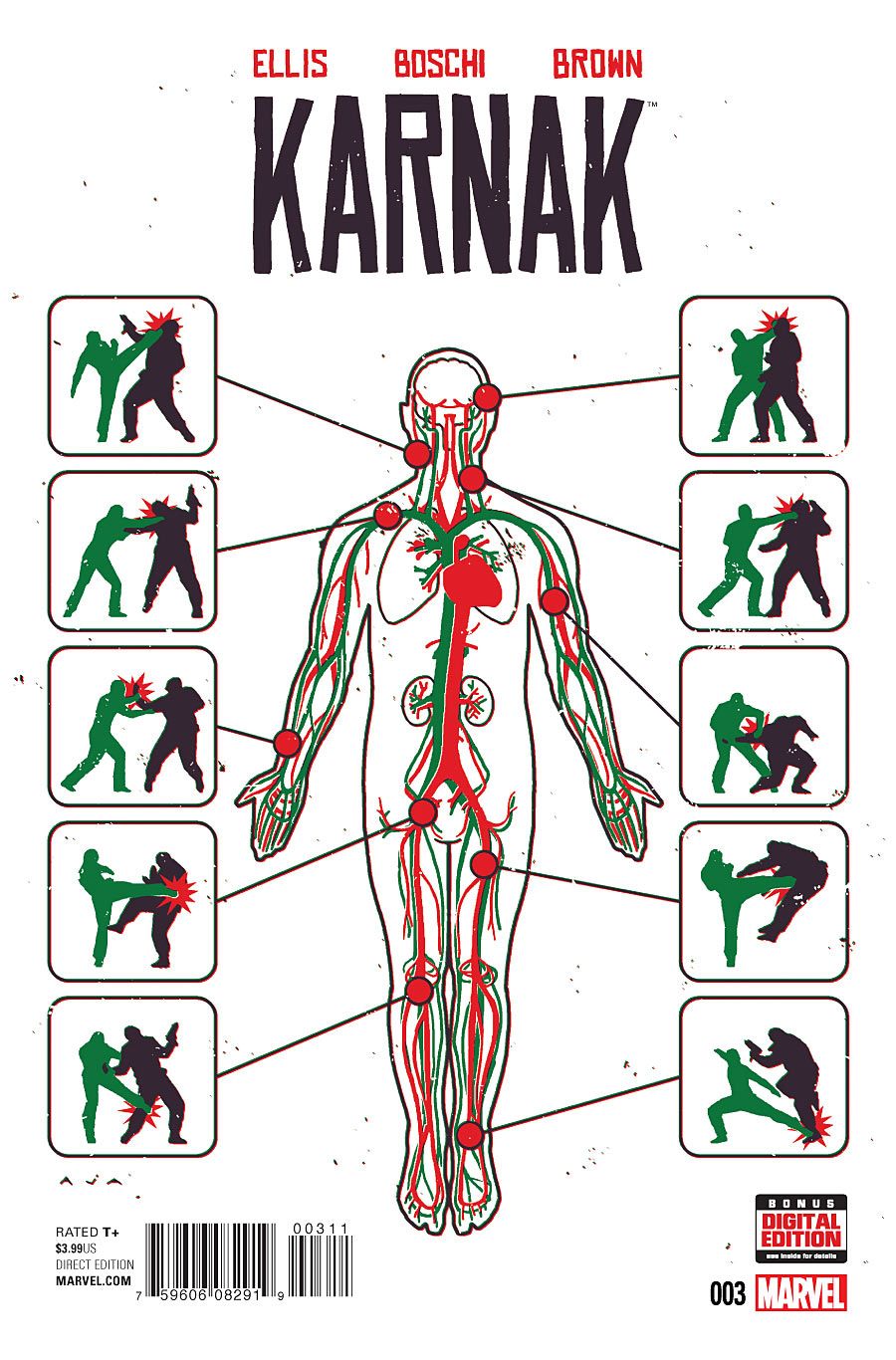Warren Ellis and Roland Boschi's "Karnak" #3 picks up right after the end of "Karnak" #2. Boschi was an inspired choice to take over the art from Geraldo Zaffino; his linework has similar delicacy, tension and confidence, with a range of mark-making and lots of dark ink. He is assisted by Dan Brown's moody color palette, which continues unbroken in style and mood. His background details are lovely, especially the oil-pastel and brush-like marks for outlines and shadows.
However, the cafe scene itself feels anticlimactic. After some opaque mystical comments on "three worlds," Ellis breaks the spell and ends the scene with a flippant joke. It's funny, but it also feels like a shot at the reader for taking the atmosphere and Karnak's musings seriously.
In the next scene, Ellis reveals Karnak's hypothesis about the reason behind the Inhuman boy's kidnapping. Karnak's guess is a clever riddle in itself; with Karnak, Ellis has created a distinctive, inventive and scary ability. The intense coral and magenta color in this debriefing scene are oppressive, but deliberately so. On the page after the revelation, Boschi expertly manipulates the dramatic tension with narrow panels, until he lets the reader breathe again with a long rectangular exhale at the bottom.
Ellis' script also wisely includes many silent panels, where the lack of noise and sheer beauty of Boschi's art urge the reader to shift into an appreciative, meditative state. Brown's colors enhance the emotional effects. The abrupt shift from a midnight blue sky to a yellow and orange dawn breaking across waves like furrowed fields is particularly moving.
Ellis' plot takes a further turn into the abstruse in a talking heads scene between Karnak and Ellis after sunrise. Unlike the boy's possible powers, the revealed meaning of name of "The Chapel of The Single Shadow" is a letdown. The postmodern artwork and symbolic wordplay feel too self-satisfied. Of course, that fits with Karnak's characterization, but a doomsday cult is not a new concept or villain, and Ellis' elaborate window dressing doesn't add much. However, Boschi's shading and illumination are impeccable; Coulson's dark silhouette looks iconic, as do Karnak's glowing, pupil-less eyes.
Boschi also continues using zip-a-tone shading to create an eerie sense of the supernatural, although he doesn't use it as liberally and enthusiastically as Zaffino did. Sadly, he seems to dispense of its use by the end of the issue. The climax features plenty of Karnak's spooky abilities, but no zip-a-tone. Brown's color work is also less interesting past the midpoint of "Karnak" #3. The slate gray and pallid blues and purples in the setting make a point, but they also detract from the details of Boschi's mark-making.
Karnak himself looks very much the same as before and his facial expression in the final panel is chilling, but Boschi's Phil Coulson doesn't command the attention or have the presence that he should. His facial features also vary too much from panel to panel. Zaffino, aided by Ellis' dialogue, captured some of the whimsical charm and bounce of actor Clark Gregg. That side of Coulson is absent in "Karnak" #3, though, even when there's dry humor to be found in Coulson's dialogue, nor do any of the other supporting characters make an impression in any scene. In the opening arc, this isn't a huge problem, but Boschi's weakness of paying insufficient attention to the supporting cast will become more of an issue later on if left unaddressed.
Boschi's exaggerated facial proportions and Cowles' startling use of black-on-white empty word balloons build suspense in the final scene. The twist itself is predictable, given Karnak's abilities, but Boschi and Ellis' pacing is strong enough to make Karnak's words in the last panel stick the landing. Ellis' concepts are ambitious and "Karnak" #3 doesn't always live up to its own conceits, but there's an undeniable fascination to Ellis' take on this character. I'm on board for more, especially if the release schedule gets back on track.

